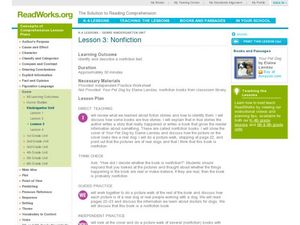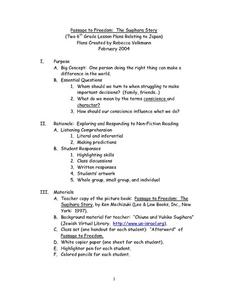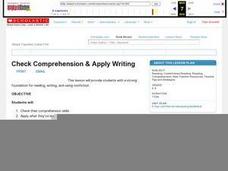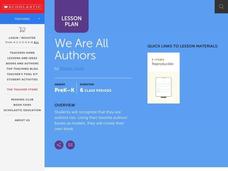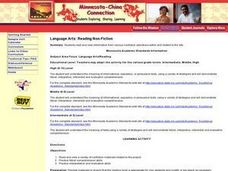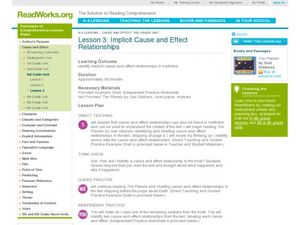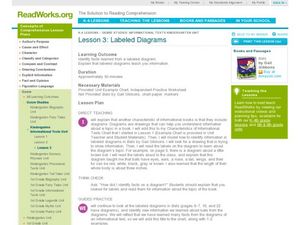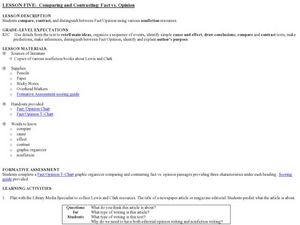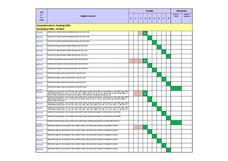Curated OER
Wood
Students practice reading comprehension strategies. In this literacy and science lesson, students read a non-fiction article about wood and locate main ideas and details. Students construct a card game using information taken from the text.
Curated OER
Non-Fiction Read-aloud
Learners listen to the reading of a book about the area of science they are currently studying.
Curated OER
Lesson 3: Nonfiction
Introduce young readers to the word of non-fiction. They examine the features found in non-fiction books such as, facts, dates, and realistic pictures. They discuss how the images in the book Your Pet Dog depict real dogs...
Santillana USA
Celebra Kwanzaa
¡Celebramos Kwanzaa! Celebrate Kwanzaa through the fictional story Celebra Kwanzaa con Botitas y sus gatitos to delightfully explain the seven principles of Kwanzaa. Dual language learners participate in reading and vocabulary...
Curated OER
Essential Meaning in Text Using Non-fiction Information Source
Students practice the skill of summarizing in writing the content of a passage or text and point out the main points in the story. They revise their skills on note-taking that they took the semester before and fine tune them more...
Curated OER
Lesson 1:Using Headings to Determine the Main Idea (nonfiction)
Sometimes all you need is a good heading to determine the main idea in a block of text. Young readers learn how to use headings to guild them to determining the main idea. They practice as a class, in pairs, and then on their own. The...
Curated OER
Short and Sweet
Students explore how to summarize a text while reading. They discuss what it means to summarize. Students read a non-fiction text and practice summarizing the pages they read. They highlight the main ideas and important details within...
Curated OER
Passage to Freedom: The Sugihara Story
Sixth graders engage in the reading of a non-fiction text in order to acquire character traits as displayed in the text.The story builds reading fluency through the teacher modeling correct style and speed.
Melissa Institute for Violence Prevention and Treatment
Concept Muraling
Concept muraling helps learners improve their comprehension of a text by giving them a way to organize their understanding of the key concepts in that text. Introduce readers to this process with a carefully scaffolded lesson that models...
Curated OER
Check Comprehension and Apply Writing
Elementary schoolers practice the skill of non-fiction writing. They study aspects of the famous Leaning Tower of Pisa, and write an essay which describes the tower and it's fascinating history. The article about the tower is included in...
Curated OER
Berlioz the Bear
Young children read the story, Berlioz the Bear and complete various reading and writing activities. They learn about fiction and non-fiction, and complete graphing and writing activities for the story. Youngsters draw the bear and use...
Curated OER
Choosing Words Carefully
Use literacy tools to select precise vocabulary. High schoolers respond to discussion questions that require them to consider the denotation and connotation of words. They then read non-fiction passages and identify words in the passages...
Curated OER
We Are All Authors
Read and discuss a variety of books by different authors and have your class create their own book. They will identify the different parts of a book, then using a story they have already written, they enter their story and information...
Curated OER
Deduction
Young scholars investigate the linguistic devices used by writers to create meaning. In this writing lesson, students discover why writers write in different ways showing examples of different types of text. After reading each type young...
Curated OER
Language Arts: Reading Non-Fiction
Students read and view information sent from seven high school students who travel to China. The daily reports that they send back to the weblog section of the site should be of high interest to students in Minnesota.
Curated OER
Implicit Cause and Effect Relationships
Cause and effect relationships can be found in both fiction and non-fiction texts. As they read the book, The Planets by Gail Gibbons, learners keep an eye out for cause and effect relationships. They chart all of the causes and effects...
Curated OER
Lesson 3: Encyclopedias
After being introduced to non-fiction texts, second graders meet a different type of non-fiction text that can help them locate factual information. They discuss and examine all of the features found in typical encyclopedias such...
Curated OER
Summarizing and Mapping for Comprehension
Students practice summarization in order to increase their comprehension of non-fiction text. They read and summarize passages by finding the main ideas in passages from a Social Studies textbook. After silently reading the passage they...
Curated OER
Discovering Ourselves in Literature and Life
Students read literature and view other media to discover how print and non-print texts answer the thematic question: Who am I? students compare the ways ideas are presented, and create their own portfolios or personal Web pages...
Curated OER
Labeled Diagrams
Let's learn about bats! Those flying creatures of the night inspire a instructional activity about non-fiction books. They start by charting characteristics commonly found in informational texts, specifically charts, diagrams, and...
Curated OER
Comparing and Contrasting: Fact vs. Opinion
Elementary schoolers investigate nonfiction stories by analyzing facts and opinions. They read nonfiction stories about the Lewis and Clark expedition. Pupils utilize a T-chart to list the facts and opinions on opposite sides, and then...
Pennsylvania Department of Education
Stories? Information? What's the Difference?
Students listen to a power point presentation to distinguish between fiction and nonfiction text. In this what's the difference lesson plan, students identify fact from opinion within a text. Students listen critically and respond to text.
Curated OER
Summarizing Key Information
Students summarize information. In this language arts lesson, students summarize information from a fictional text. Students read a folktale and summarize the story.
Curated OER
Using Non-Text Features
Second graders examine graphs and charts from their local newspaper. As a class, they discuss what the data means and how it relates to the article. In groups, they are shown two sets of graphs or charts and they practice explaining...
Other popular searches
- Non Fiction Text Features
- Non Fiction Text Features
- Non Fiction Text Structures
- Reading Non Fiction Text
- Non Fiction Text Parts
- Non Fiction Text Samples
- Features of Non Fiction Text
- Text Elements of Non Fiction
- Summarizing Non Fiction Text
- Summarize Non Fiction Text
- Summarizing Non Fiction Text
- Non Fiction Text Elements


